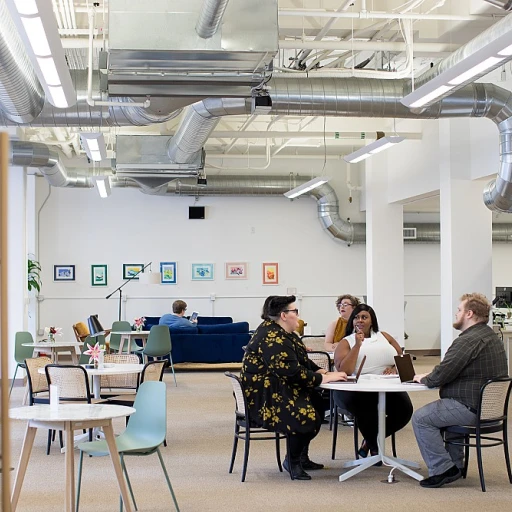
Defining Lateral Transfer in HR
The Basics of Lateral Transfer in Human Resources
Lateral transfer in the realm of human resources can be viewed as a strategic approach to career mobility within an organization. Unlike traditional promotions that focus on vertical moves up the career ladder, lateral transfers involve shifting employees to a different role or job within the same company at a similar level of responsibility.
This practice is guided by the principle of enhancing internal mobility and can sometimes be more beneficial to both employees and employers in the long term. For employees, lateral transfers present opportunities for skill development and gaining new experiences, which can ultimately lead to greater job satisfaction and alignment with personal career goals. For employers, facilitating such transfers helps in retaining talent and promoting a culture of continuous career development.
In today's ever-evolving business landscape, the implementation and success of lateral transfers have been significantly aided by AI-powered solutions. These technologies assist in identifying cross-functional opportunities and aligning them with the skills and aspirations of employees, making it easier to execute these career moves effectively.
Lateral transfers can sometimes be challenging, especially when it comes to aligning the pay grade and expectations between different roles. Understanding how to manage these challenges is key to ensuring successful employee transfers within an organization.
The Role of AI in Facilitating Lateral Transfers
AI-Powered Transformation in Facilitating Lateral Transfers
The integration of artificial intelligence in human resources has fundamentally transformed how companies manage and facilitate lateral transfers. AI's capabilities are particularly instrumental in enhancing employee mobility and offering new career opportunities within an organization. AI systems are adept at analyzing vast amounts of data, making them valuable in identifying potential lateral career moves for employees. These systems can assess employee skills, job performance, and career goals to suggest suitable lateral job opportunities that align with both individual aspirations and organizational needs. By promoting internal mobility, AI supports not only the growth of employees, but also the strategic interests of the company. Moreover, AI can help streamline the lateral transfer process by matching employees to roles where they can best utilize their skills, thereby contributing to job satisfaction and career development. This cross-functional alignment allows employees to explore new roles and gain diverse experiences without necessarily undergoing a vertical move. In terms of workflow, AI can automate many aspects of the transfer process. This includes handling initial assessments, scheduling interviews, and even managing training sessions essential for employees in their new positions. Automation allows HR professionals to focus more on strategic functions, ensuring that the transfer process is smooth and efficient. However, implementing AI solutions requires an understanding of its potential and limitations in the context of human resources. For a more comprehensive overview of AI's role in HR, exploring resources such as this detailed insight on HR AI implementations can be invaluable. As organizations continue to embrace digital transformation, AI's role in enabling effective lateral moves will only expand, offering both employers and employees the tools necessary for adapting to an ever-changing job landscape.Benefits of Lateral Transfers for Employees and Employers
Advantages for Both Employees and Employers
Lateral transfers bring significant benefits to both employees and employers, fostering a dynamic and adaptable work environment. For employees, these transfers offer a unique opportunity to broaden their skill sets and gain valuable experiences across different roles within a company. This not only aids in skill development but also supports long-term career growth and job satisfaction. Employees who engage in lateral moves can uncover new career paths and aspirations, aligning them with their career goals more effectively. On the other hand, from an employer's perspective, facilitating lateral transfers helps in building a more versatile workforce. When employees gain exposure to various roles and challenges, they contribute to the company with a refreshed perspective and a wider array of skills. This mobility can be pivotal during organizational transformations, ensuring that experienced and passionate personnel fill roles that require intricate company knowledge. Moreover, lateral transfers can promote a culture of internal mobility, encouraging employees to consider growth opportunities within their current organization rather than seeking career development externally. This internal focus not only boosts morale but also reduces turnover, as employees perceive themselves as valued members of an organization committed to their development. Another significant advantage is the optimization of skills within the organization. By moving employees laterally, companies can better place individuals where their current capabilities can be maximally utilized while simultaneously offering them the chance to cultivate new skills. This balance fosters an environment of continuous learning and adaptation, crucial for both personal and professional growth. For more insights on the role of HR professionals in facilitating these dynamic changes in the age of AI, consider exploring the importance of HR professionals in the age of AI.Challenges in Implementing Lateral Transfers
Addressing Complexities and Hurdles in Implementing a Lateral Move
Implementing lateral transfers within an organization is often seen as a strategic move to enhance career mobility and internal talent growth. However, the journey is not devoid of its own set of challenges that both companies and employees must navigate. Understanding these challenges is crucial for maximizing the potential benefits of lateral career moves.
One significant challenge in rolling out lateral transfers is ensuring that employees are ready for a new role that might require adapting to different expectations without a change in pay grade. Employees might perceive their lateral move as lacking progression, which can dampen job satisfaction and hinder long-term career development. Organizations need to carefully communicate the advantages of skill development and career growth opportunities that arise from experiencing diverse roles.
The complexity of matching employees with the right roles during lateral transfers is another hurdle. This process requires a deep understanding of both the employee's current skills and the demands of the new position. Companies often struggle with determining the right fit for lateral moves without compromising on productivity and efficiency.
Organizations also face challenges in aligning lateral transfers with overall career goals of employees. Facilitating a job transfer that complements an employee's aspirations requires nuanced career planning and consideration of individual ambitions. Misalignment might lead to higher turnover rates if employees feel that their career moves do not support their personal growth path.
Lastly, fostering a culture that embraces internal mobility and lateral transfers demands championing open communication and support from leadership. Employees need to be assured that a lateral move is valued equally as a vertical advance in terms of career impact and opportunities for development. Without strong organizational backing, the implementation of lateral transfers may falter.
While the challenges are tangible, acknowledging them is the first step toward a successful implementation. Clear communication, strategic matching, and a supportive culture are key ingredients in overcoming the barriers associated with lateral transfers in the professional landscape.
Case Studies: Successful Lateral Transfers with AI
Real-World Examples of AI-Powered Lateral Transfers
In recent years, the integration of AI has significantly influenced lateral transfers within organizations, resulting in more effective internal mobility strategies. This influence is evidenced by several companies that have successfully implemented AI to support their lateral and cross-functional operations. Let's dive into some notable examples.One large multinational organization redesigned its employee mobility framework with the help of AI, focusing on facilitating career development through lateral moves. This company utilized AI platforms to categorize roles by skills and then matched employees possessing relevant competencies. This process not only ensured that employees moved to suitable positions but also promoted enhanced job satisfaction and career growth. A focus on employee skill development facilitated more informed career moves, resulting in successful lateral transfers.
Another corporation, known for its innovative workforce solutions, leveraged AI algorithms to break down silos between departments. By analyzing data on employee skills and interests, they were able to identify potential lateral move opportunities that aligned with individual career goals. This process encouraged long-term career development by providing employees with new challenges outside of their traditional career paths, while also fulfilling organizational needs for versatile skill sets.
Implementing AI for internal mobility has also been beneficial in aligning employee positions with business strategy. A financial institution used AI-driven analytics to assess lateral mobility opportunities, matching employee desires for growth with the company's strategic priorities. This ensured that lateral transfers were not only beneficial for employees in terms of career and skill development but also positioned the company competitively within the market.
The success stories of these organizations illustrate the significant role AI plays in simplifying the complex process of lateral job transfers. This has led to effective internal mobility, optimized organizational resources, and improved company-wide job satisfaction.The future of lateral job transfers, as previously discussed, seems promising with AI integration, paving the way for more dynamic career paths within companies and across industries. These case studies demonstrate how optimizing career mobility with the aid of AI can reshape the employee transfer landscape and encourage a culture of continuous learning and adaptability.












